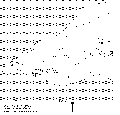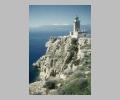
Rectangular hearth building; Sanctuary of Hera Auraia. Perachora.

Upper sanctuary at the the Temple of Hera Auraia, Perachora.

Dining room; Sanctuary of Hera Auraia. Perachora.
| Summary: | Sanctuary of Hera. |
| Type: | Sanctuary |
| Region: | Corinthia |
Periods:
Geometric
Archaic
Classical
Hellenistic
Physical:
Located on a large promontory at E end of Corinthian Gulf, N of the Isthmus and opposite ancient Corinth, near the fortified town of Peraion. Two sacred precincts existed: Hera Limenia above the harbor with an 8th century B.C. temple and Hera Akraia by the harbor with a 6th century B.C. temple. House remains, cisterns, an agora and stoa were part of the settlement around the sanctuaries. There may have been an oracle at the sanctuaries.
Description:
Perhaps due to the scarcity of fresh water, there was no settlement and only occasional habitation on the Perachora promontory prior to the Geometric period when the territory (originally belonging to Megara) came under Corinthian control. It was strategically important that Corinth control the Perachora because it could serve an enemy as a strong base near the Isthmus and Corinth and because it provided an ideal observation point for ship movement in the whole W part of the Corinthian Gulf.
The 1st temple and precinct of Hera Akraia was established by the Corinthians on the W tip of the promontory early in the Geometric period. There is strong indication that Argos also played a role in the foundation of this new Heraion.
In the later Geometric period (2nd half of the 8th century B.C.), a 2nd temple and precinct, the so-called Hera Limenia, was built ca. 200 m E and up the valley from the 1st precinct. The 2nd enclosure may have been a separate sanctuary dedicated to Hera Limenia, or it may have been an extension or annex to the precinct of Hera Akraia. In the latter case the 2nd (8th century) temple may have replaced the original temple at the shore or it may have been a treasury or structure to house the ever accumulating votive offerings of Hera rather than an actual temple. The original sacred precinct of Hera Akraia is in a confined space hemmed in by sea and cliffs and a large number of offerings and votive gifts were brought into the sanctuary during the 8th century B.C. An annex to the popular sanctuary of Hera Akraia appears more logical than the construction of a new and competitive sanctuary of Hera.
After the establishment of the Hera Limenia precinct the original shore side precinct of Hera Akraia was renovated and a new temple of Hera built in the 6th century B.C.
From the 8th century through the Classical period, votive gifts and offerings continue to enrich both precincts. In the 8th and 7th centuries B.C. Corinth became more independent from Argos and began to send out colonists and traders to the W. The Hera sanctuary was the last point of Corinthian territory that colonists would pass and the first point that returning merchants would reach and this undoubtedly accounted for many offerings to secure or give thanks for safe voyages and enterprises.
The Classical period brought another phase of building activity at the sanctuary. The area of the Hera Akraia precinct was remodeled and a stoa and agora were added. The approach to the Hera Limenia precinct and part of that temenos were also remodeled.
There had been habitations and fortifications built in the neighborhood of the sanctuary as early as the original Geometric period foundations and additional buildings of this nature appear in the Classical period.
The Heraion was still important and active in the Hellenistic period and new buildings and cisterns appear in the neighborhood. The sanctuary, however, had been completely abandoned after the Roman sack of 146 B.C. and Roman houses were built over its ruins.
Exploration:
Excavations: 1930-33, H. Payne, British School of Archaeology.
Sources Used:
Other Bibliography:


